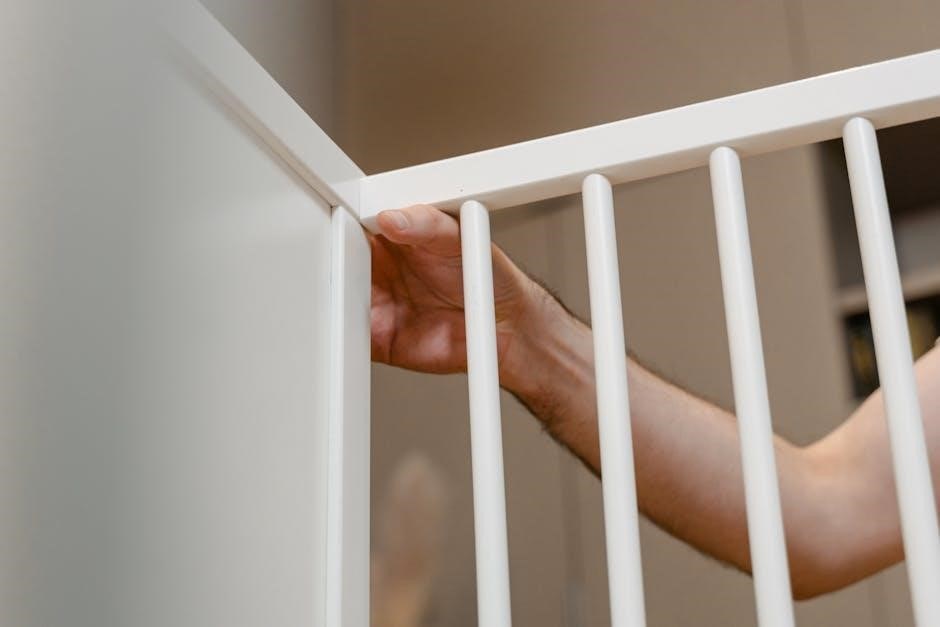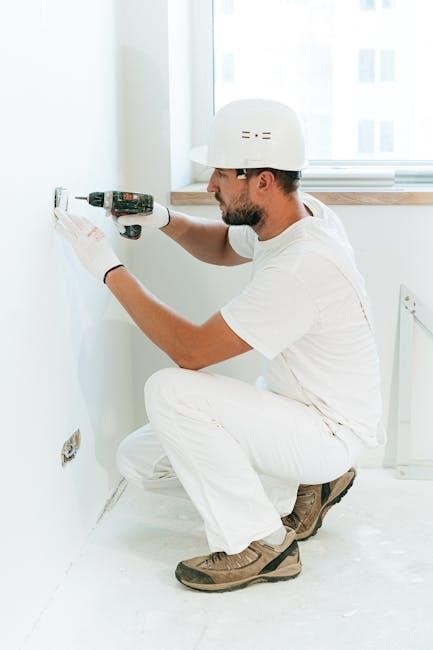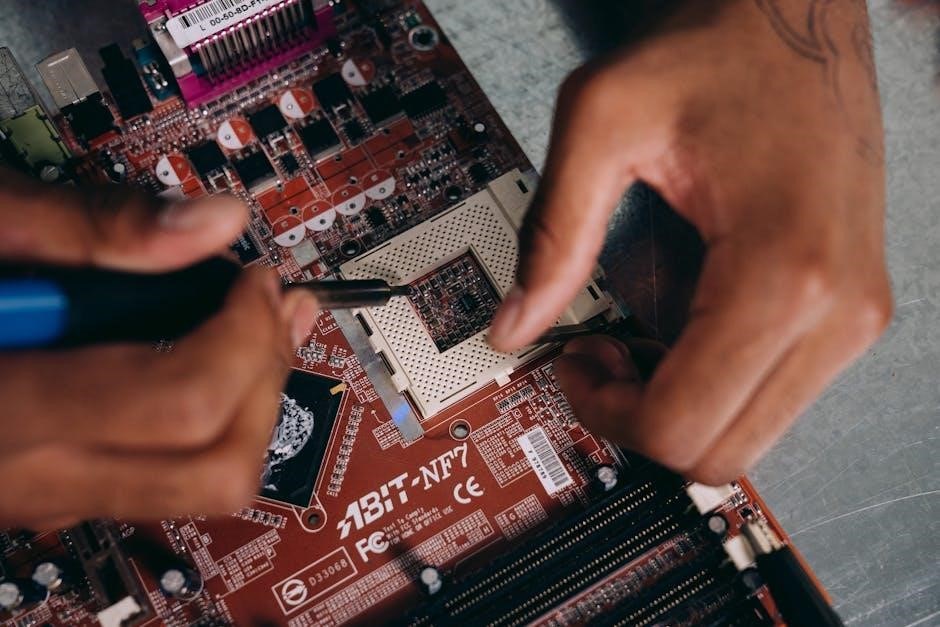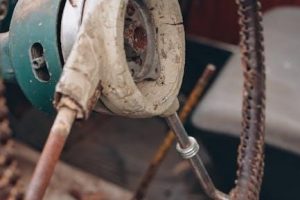Honeywell T1 Pro Installation Manual: A Comprehensive Guide
This guide provides detailed instructions for installing your Honeywell T1 Pro non-programmable thermostat. It covers everything from unpacking the components to wiring connections and initial setup‚ ensuring a smooth and successful installation for your home’s heating and cooling system. Follow each step carefully!
Package Contents
Before beginning the installation process‚ it is crucial to verify that all components are present in the packaging. The standard Honeywell T1 Pro thermostat package typically includes the T1 Pro Thermostat itself‚ which is the main control unit. Additionally‚ you should find the UWP (Universal Wiring Platform) mounting system‚ designed for easy and secure wall attachment. Some packages also contain a Honeywell standard installation adapter‚ commonly referred to as a J-box adapter‚ facilitating installation in junction box setups.
Furthermore‚ a decorative cover plate is usually included to provide a clean and aesthetically pleasing finish after installation‚ concealing any mounting hardware. Essential hardware like screws and anchors are also part of the package‚ ensuring a stable and reliable mount on various wall surfaces. Lastly‚ two AA batteries are generally provided to power the thermostat‚ although their use depends on your wiring configuration.
Carefully cross-reference these components with the list provided in the manual to confirm you have everything needed for a successful thermostat installation. If any item is missing‚ contact Honeywell customer support.
UWP Mounting System
The UWP (Universal Wiring Platform) Mounting System is a critical component for installing the Honeywell T1 Pro thermostat. Before you start‚ ensure the power is off at the breaker or switch. The UWP serves as the base to which the thermostat attaches‚ simplifying the wiring and mounting process. Begin by separating the UWP from any attached cover plates or adapters. Position the UWP on the wall where you intend to install the thermostat‚ ensuring it is level using a spirit level.
Mark the locations for the mounting screws through the UWP’s designated holes. Drill pilot holes at these marked positions‚ using appropriately sized drill bits for your wall type. Insert the provided anchors into the drilled holes if you’re mounting on drywall or other soft materials. Secure the UWP to the wall using the supplied screws‚ ensuring it is firmly attached and level.
The UWP is designed to accommodate various wiring configurations‚ making it compatible with different HVAC systems. Once the UWP is securely mounted‚ you can proceed with connecting the wiring according to the wiring diagram in the manual. Remember to consult the manual for specific instructions.
Standard Installation Adapter (J-Box Adapter)
The Standard Installation Adapter‚ also known as the J-Box Adapter‚ is designed to facilitate the mounting of the Honeywell T1 Pro thermostat onto a standard junction box. This adapter is particularly useful when replacing an existing thermostat that was already connected to a J-box‚ providing a clean and professional installation. Before starting‚ always ensure that the power to the junction box is turned off at the breaker.
Begin by detaching the J-Box Adapter from any other components it may be connected to‚ such as the decorative cover plate. Align the adapter with the screw holes on the junction box. Secure the adapter to the J-box using the appropriate screws. Ensure the adapter is firmly attached and provides a stable base for the thermostat.
The J-Box Adapter typically has openings or channels to allow for easy routing of the thermostat wires. Carefully thread the wires through these openings‚ ensuring they are not pinched or damaged. Once the adapter is securely mounted and the wires are routed‚ you can proceed with connecting the wires to the UWP mounting system according to the wiring diagram provided in the installation manual. Double-check all connections before proceeding.
Decorative Cover Plate

The decorative cover plate included with the Honeywell T1 Pro thermostat serves both an aesthetic and functional purpose. Aesthetically‚ it provides a clean and finished look by concealing any unsightly wall imperfections or paint lines left behind by the previous thermostat. Functionally‚ it can offer additional protection to the thermostat and the wall behind it.
The cover plate is designed for easy installation. After the UWP mounting system or J-Box adapter is securely attached to the wall and all wiring connections are completed‚ the decorative cover plate can be mounted. Align the cover plate with the mounting system. Gently press the cover plate onto the mounting system until it snaps into place or is secured by screws‚ depending on the model.
Ensure the cover plate is flush against the wall and securely attached to prevent any gaps or movement. A properly installed cover plate enhances the overall appearance of the thermostat installation. If a smaller cover plate is included‚ choose the one that best fits the dimensions of the previous thermostat’s footprint for optimal coverage. This step is crucial for achieving a professional and visually appealing installation.

Screws and Anchors
The Honeywell T1 Pro installation kit includes screws and anchors for securing the UWP mounting system or the standard installation adapter (J-Box adapter) to the wall. Selecting the appropriate hardware is crucial for a stable and reliable thermostat installation. Use the provided screws and anchors to ensure compatibility with the mounting system and the wall material.
Before drilling any holes‚ determine the type of wall you are working with (e.g.‚ drywall‚ plaster‚ or wood). If installing into drywall or plaster‚ use the provided anchors to create a secure hold for the screws. Position the UWP mounting system on the wall and mark the screw hole locations. Drill pilot holes at the marked locations‚ ensuring they are slightly smaller than the anchors. Insert the anchors into the pilot holes‚ tapping them gently with a hammer if necessary.
Align the UWP mounting system with the anchors and use the provided screws to attach it to the wall. Tighten the screws until the mounting system is snug against the wall‚ but avoid over-tightening‚ which could damage the anchors or the wall. If installing into wood‚ you may not need to use anchors. Use the appropriate length screws to securely attach the mounting system to the wall. A level installation guarantees the thermostat functions correctly and looks professional.
Battery Installation
The Honeywell T1 Pro thermostat requires two AA batteries for operation‚ providing either primary or backup power. Battery installation is a straightforward process‚ ensuring the thermostat continues to function even during power outages. To install the batteries‚ first locate the battery compartment on the thermostat‚ typically found on the front or back of the unit.
Open the battery compartment by sliding the cover or pressing a release tab‚ depending on the model. Insert the two AA batteries into the compartment‚ ensuring they are oriented correctly according to the polarity markings (+ and -) inside the compartment. Incorrect battery polarity can prevent the thermostat from functioning properly or even damage the device.
Once the batteries are inserted‚ close the battery compartment securely. The thermostat display should illuminate‚ indicating that the batteries are providing power. If the display does not light up‚ double-check the battery polarity and ensure the batteries are fresh. The thermostat may display a low battery warning when the batteries are running low‚ prompting you to replace them.
While the T1 Pro can operate on battery power alone‚ it is recommended to also connect the thermostat to a C-wire for continuous power. This will extend battery life and ensure reliable operation. Regularly check the battery status and replace them as needed to maintain optimal performance.
Wiring Connections
Proper wiring is crucial for the Honeywell T1 Pro thermostat to function correctly with your heating and cooling system. Before making any wiring connections‚ always turn off the power to your HVAC system at the breaker box or switch to prevent electrical shock. Identify the existing wires connected to your old thermostat‚ noting their colors and terminal designations (e.g.‚ R‚ W‚ Y‚ G‚ C).
The T1 Pro utilizes a UWP mounting system for easy wiring. Match the wires from your HVAC system to the corresponding terminals on the UWP backplate. Common terminal connections include: R (power)‚ W (heat)‚ Y (cool)‚ G (fan)‚ and C (common). If you have a heat pump system‚ you may also have O/B terminals for reversing valve control.
Insert each wire into the appropriate terminal‚ ensuring a secure connection. Some terminals may have push-in connectors‚ while others require tightening a screw. Consult the wiring diagram in the installation manual for specific guidance on your system configuration. A C-wire is recommended for stable power‚ even if batteries are installed.
After all wires are connected‚ carefully tuck them into the wall cavity to avoid obstructing the thermostat. Double-check all connections to ensure they are secure and properly matched to the correct terminals. Incorrect wiring can damage the thermostat or your HVAC equipment. If you are unsure about the wiring‚ consult a qualified HVAC professional.
Power Considerations (R and C Wires)
The Honeywell T1 Pro thermostat requires a stable power supply to operate reliably. While it can function on battery power alone‚ utilizing both the R and C wires is highly recommended for optimal performance and to prevent unexpected battery depletion.
The R wire provides the primary source of power from your HVAC system’s transformer. In some systems‚ there may be separate Rh (heating) and Rc (cooling) wires. If this is the case‚ ensure they are properly connected to the corresponding R terminals on the thermostat’s UWP mounting system‚ or use a jumper wire if required by the system.
The C wire‚ also known as the common wire‚ provides a continuous return path for the electrical circuit. While not always required for basic thermostat operation‚ the C wire significantly enhances stability and prevents issues such as flickering displays or erratic behavior. Without a C wire‚ the thermostat may draw power through other components‚ potentially shortening their lifespan.
If your existing wiring does not include a C wire‚ you may need to install one. This can involve running a new wire from the thermostat to the HVAC system’s control board. Consult the HVAC system’s documentation and a qualified technician for guidance on adding a C wire safely.
Connecting both the R and C wires ensures a consistent and reliable power supply‚ maximizing the performance and lifespan of your Honeywell T1 Pro thermostat. Ensure the wires are properly inserted.

Accessing Installer Setup (ISU)
The Installer Setup (ISU) menu on the Honeywell T1 Pro thermostat provides access to advanced configuration options‚ allowing you to customize the thermostat’s behavior to match your specific HVAC system and preferences. Accessing the ISU is essential for fine-tuning the thermostat’s performance and ensuring compatibility with your heating and cooling equipment.
To enter the ISU‚ simultaneously press and hold the “Menu” button and the “+” button (typically the up arrow) on the thermostat’s display for approximately 5 seconds. The screen will change to indicate that you have entered the advanced menu.
Once in the advanced menu‚ use the “Select” button to navigate to the “System Setup” or “ISU” option. Press “Select” again to enter the ISU menu;
Within the ISU‚ you can cycle through various settings using the “Select” button. Each setting is identified by a number. To modify a setting‚ use the “+” (up arrow) or “-” (down arrow) buttons to change the value or select from available options.
It’s crucial to consult the Honeywell T1 Pro installation manual or the manufacturer’s website for a comprehensive list of ISU settings and their corresponding functions. Incorrectly configured settings can lead to improper operation of your HVAC system.
After making your desired changes‚ navigate to the “Done” or “Exit” option in the ISU menu and press “Select” to save your settings and exit the advanced menu. The thermostat will then return to its normal operating mode.
System Operation Settings
The Honeywell T1 Pro thermostat offers several system operation settings within the Installer Setup (ISU) menu that allow you to configure how the thermostat controls your heating and cooling system. These settings are critical for ensuring optimal performance and energy efficiency.
One important setting is the system type‚ which specifies whether you have a heat-only‚ cool-only‚ or heat/cool system. Selecting the correct system type is crucial for proper operation.
Another key setting is the heating cycle rate or CPH (Cycles Per Hour). This setting determines how frequently the thermostat cycles the heating system on and off to maintain the desired temperature. Adjusting the CPH can improve comfort and energy efficiency. A lower CPH generally results in longer heating cycles and more consistent temperatures‚ while a higher CPH results in shorter cycles and potentially more temperature fluctuations.
The cooling cycle rate setting works similarly for cooling systems. It controls how often the cooling system cycles on and off.
Some T1 Pro models may also offer settings related to heat pump systems‚ such as reversing valve operation (O/B) and auxiliary heat control. These settings are specific to heat pump installations and should be configured according to the manufacturer’s recommendations.
For each setting‚ consult the Honeywell T1 Pro installation manual to understand the available options and their implications. Selecting the appropriate system operation settings will ensure that your thermostat effectively manages your HVAC system and provides comfortable and efficient climate control.

Fan Operation Settings
The Honeywell T1 Pro thermostat provides options for configuring the fan operation‚ allowing you to customize how the fan in your HVAC system runs. These settings are accessible through the Installer Setup (ISU) menu and offer two primary modes: Auto and On.
In “Auto” mode‚ the fan operates only when the heating or cooling system is actively running; This is the most energy-efficient setting‚ as the fan only consumes power when needed to distribute conditioned air. When the heating or cooling cycle ends‚ the fan automatically shuts off.
In “On” mode‚ the fan runs continuously‚ regardless of whether the heating or cooling system is active. This setting provides constant air circulation‚ which can help to improve temperature consistency throughout your home and filter air continuously. However‚ it also consumes more energy than “Auto” mode.
Selecting the appropriate fan operation setting depends on your preferences and needs. If energy efficiency is a priority‚ “Auto” mode is the best choice. If you prefer constant air circulation and more consistent temperatures‚ “On” mode may be more suitable.
To access the fan operation settings‚ press and hold the Menu button for approximately 3 seconds to enter the menu‚ then navigate to the fan control option. Use the Edit button to change the value between “Auto” and “On”. Refer to the Honeywell T1 Pro installation manual for specific instructions and further details on fan operation settings.
Setting Fahrenheit or Celsius
The Honeywell T1 Pro thermostat allows you to display the temperature in either Fahrenheit (°F) or Celsius (°C)‚ catering to your personal preference or regional standard. Changing the temperature scale is a straightforward process accomplished through the Installer Setup (ISU) menu.
To switch between Fahrenheit and Celsius‚ begin by accessing the ISU menu. This typically involves pressing and holding the Menu button for a few seconds until the advanced settings appear. Once in the ISU menu‚ navigate through the options until you locate the setting related to temperature units – it may be labeled “Temperature Scale‚” “Units‚” or something similar.
Upon selecting the temperature units setting‚ you should be presented with the choice between Fahrenheit (°F) and Celsius (°C). Use the appropriate buttons‚ usually the up and down arrows or plus and minus buttons‚ to toggle between the two options. Once you have selected your desired temperature scale‚ confirm your selection and exit the ISU menu.
After exiting the ISU menu‚ the thermostat display will immediately update to reflect your chosen temperature scale. All temperature readings‚ including the current room temperature and setpoint temperatures‚ will be displayed in either Fahrenheit or Celsius‚ depending on your selection.
Refer to the Honeywell T1 Pro installation manual for precise steps and illustrations specific to your thermostat model‚ ensuring accurate navigation and setting changes within the ISU menu.





